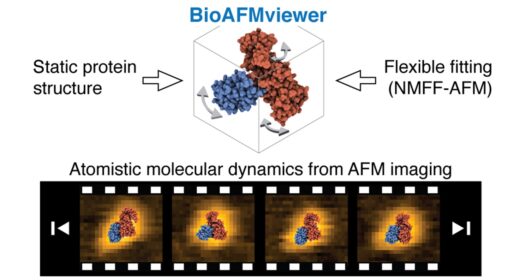Modeling atomistic biomolecular dynamics from HS-AFM imaging
A collaboration team of researchers from the Nano Life Science Institute (WPI-NanoLSI), Kanazawa University, the Institute of Transformative Bio-Molecules (WPI-ITbM), Graduate School of Science at Nagoya University, and the RIKEN Center for Computational Science (R-CCS) reports in ACS Nano an integrative modeling workflow to understand with atomistic precision biomolecular dynamics from high-speed atomic force microscopy experiments.
High-speed atomic force microscopy (HS-AFM) is the only experimental technique to directly watch proteins in dynamic action. However, as a surface scanning technique with limited spatial resolution, HS-AFM will inevitably provide insufficient information for detailed atomistic understanding of biomolecular function. Despite previous efforts in computational modeling attempting to overcome such limitations, successful applications to retrieve atomistic-level information from measurements are yet practically absent.
A research team led by Holger Flechsig (WPI-NanoLSI, Kanazawa University) and Florence Tama (WPI-ITbM, Graduate School of Science at Nagoya University, and R-CCS) now presents a computational framework and its software implementation allowing to infer 3D atomistic models of dynamic protein conformations from AFM topography imaging. The scientists use a new computationally efficient flexible fitting method developed by Tama’s group, which models conformational dynamics of known static protein structure to identify atomistic models that best fit experimental AFM images. In their work, they first implement this method into the well-established BioAFMviewer software platform maintained by Flechsig’s group to provide a direct workflow for applications to measured AFM imaging data.
The presented analysis of HS-AFM data for different proteins obtained by experimental collaborators (groups of Noriyuki Kodera and Hiroki Konno at WPI-NanoLSI) evidence that flexible fitting can infer atomistic models including large-amplitude motions to significantly improve understanding of functional conformational dynamics from resolution-limited measurements. Computational efficiency of flexible fitting within the BioAFMviewer even allows applications to large protein assemblies, as the authors show for the example of a 4 megadalton actin filament consisting of about 280,000 atoms. A remarkable achievement is the demonstration of an atomistic molecular movie of protein dynamics, involving functional conformational transitions, reconstructed from HS-AFM topographic movie data.
The unique software implementation of computationally efficient flexible fitting, integrating available structural data and molecular modeling with experiments, opens the opportunity for a broad range of applications to fully exploit the explanatory power of HS-AFM by large-scale analysis of single molecule imaging data toward better understanding biological processes at the nanoscale.
This work is a collaborative effort of scientists from two WPI centers in Japan, the Nano Life Science Institute (WPI-NanoLSI) at Kanazawa University, and the Institute of Transformative Bio-Molecules (WPI-ITbM) at Nagoya University. Combining the expertise of protein dynamics modeling and computational science with Nanometrology experiments, leading contributions which further advance the interdisciplinary field of nanoscale biology are achieved.

Schematic of BioAFMviewer flexible fitting to infer atomistic biomolecular dynamics from HS-AFM imaging data (image under the CC BY-NC-ND 4.0 License from the original paper).
Background
Flexible Fitting
Flexible fitting is a computational method which models conformational motions of a static protein structure to dynamically steer it into conformations that best represent experimental data. The normal mode flexible fitting AFM (NMFF-AFM) method, recently developed by Tama’s group (J. Phys. Chem. B, 2024), employs computational efficient iterative normal mode analysis to model large-amplitude conformational changes which allows to identify dynamic atomistic models that best represent measured AFM topographic images.
BioAFMviewer software
The BioAFMviewer project was initiated by Holger Flechsig in 2020, with Romain Amyot as the programming scientist, to provide a unique software platform integrating the enormous amount of available high-resolution biomolecular structure and modelling data for the analysis of resolution-limited AFM measurements. An integrated molecular viewer for biomolecular visualization, corresponding simulation AFM, and several analysis toolboxes provide a user-friendly interactive software interface for the convenient analysis of experimental AFM data. The performance of the integrated NMFF-AFM flexible fitting method is significantly enhanced by parallelized computations executed on graphic cards. The BioAFMviewer software is available for free download from the project website www.bioafmviewer.com.
Article
- Title
- Flexible Fitting to Infer Atomistic-Precision Models of Large-Amplitude Conformational Dynamics in Biomolecules from High-Speed Atomic Force Microscopy Imaging
- Author
- Romain Amyot, Osamu Miyashita, Xuan Wu, Kazusa Takeda, Noriyuki Kodera, Hiroki Konno, Florence Tama, and Holger Flechsig
- Journal
- ACS Nano
- Publication date
- Sep 18, 2025
- DOI
- 10.1021/acsnano.5c10073
- URL
- https://doi.org/10.1021/acsnano.5c10073

